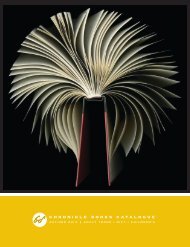pdf 1 - exhibitions international
pdf 1 - exhibitions international
pdf 1 - exhibitions international
You also want an ePaper? Increase the reach of your titles
YUMPU automatically turns print PDFs into web optimized ePapers that Google loves.
The Lego green city has low-carbon public transport and renewable-energy systems but still too many dogs.<br />
the same distance you might drive to go and buy the Lego sets one by one from<br />
an out-of-town retail centre. By comparison, a modern soldier uses 1,080MJ<br />
(25 kilograms/55lbs) of oil a day. 46 Among all the other things that are done with<br />
oil, making Lego out of it seems pretty blameless, not least because Lego bricks<br />
are so durable and emit no greenhouse gases during use.<br />
The United Kingdom’s first Autonomous House (1993), which was in the<br />
middle of a town but provided all its services from sun and rain, was made<br />
entirely from off-the-shelf materials and components. 47 Such houses could form<br />
one element of a green city. One of the nice points about the Lego version of the<br />
green city is that, like the Autonomous House, all the models are made out of<br />
standard pre-existing Lego parts. We do not need to invent anything new, either<br />
in Lego or in reality, to build the green city, we just need to choose to do it. A<br />
Lego green city can be created from available Lego sets, if you are prepared to<br />
search them out. The Lego version even has all the attributes of the European<br />
Green City Index, with its wind and solar energy systems, its public transport and<br />
waste recycling, its bicycles and medium-density housing. But the Lego version<br />
of the green city can be considered only as green as the real ones, which means<br />
not very green at all. Out of the thirty cities around Europe studied in the<br />
European Green City Index, the carbon dioxide emissions per head of the city population<br />
range from a relatively commendable 2.19 tonnes per year in Oslo to a<br />
slightly scary 9.72 tonnes per year in Dublin, but even Oslo can be described<br />
merely as ‘greener’ rather than green. After all, 2.19 tonnes is a lot for one person:<br />
it is 6 kilograms (13 lbs) a day, although nothing like as bad as the nearly 27 kilograms<br />
(60 lbs, or over 4 stone) of CO a day thrown into the atmosphere by the<br />
2<br />
average Dubliner. By comparison, Norway’s more tangible municipal waste per<br />
capita is 800 kilograms ( 4 ⁄5 tonne) a year, or only about 2.2 kilograms (5 lbs) a day,<br />
and Norway, along with Ireland, is the worst producer of waste in the OECD. 48<br />
People tend to worry about municipal waste because you can see it, but carbon<br />
dioxide is invisible and so not considered an immediate problem, even though<br />
Europe’s lowest-CO -emitting city produces three times as much of it by weight<br />
2<br />
as it does solid garbage. The conclusion is that Oslo is indeed better than Dublin,<br />
but it has a very long way to go before it could be considered green.<br />
The Lego green city reflects the token gestures of the real ones. Yes, the<br />
houses have solar panels, but houses with a solar panel or two on the roof do not<br />
have nearly enough solar input to make a useful contribution to the energy<br />
demand of the house. To stand a chance of producing enough electricity to run<br />
Lego and the Green City 187










![01 -[BE/INT-2] 2 KOL +UITGEV+ - exhibitions international](https://img.yumpu.com/19621858/1/184x260/01-be-int-2-2-kol-uitgev-exhibitions-international.jpg?quality=85)






